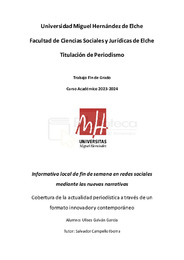Please use this identifier to cite or link to this item:
https://hdl.handle.net/11000/32677Full metadata record
| DC Field | Value | Language |
|---|---|---|
| dc.contributor.advisor | Campello Iborra, Salvador | - |
| dc.contributor.author | Galván García, Ulises | - |
| dc.contributor.other | Departamentos de la UMH::Ciencias Sociales y Humanas | es_ES |
| dc.date.accessioned | 2024-07-24T09:19:45Z | - |
| dc.date.available | 2024-07-24T09:19:45Z | - |
| dc.date.created | 2024-06 | - |
| dc.identifier.uri | https://hdl.handle.net/11000/32677 | - |
| dc.description.abstract | Este trabajo tiene como objetivo plantear un informativo local en redes sociales de acuerdo a la lógica, recursos y criterios periodísticos, científicos y psicológicos que lo abordan y apoyan. En plena era de la comunicación digital, los medios de comunicación están en plena adaptación a las nuevas narrativas y a la comunicación de información por medios más a mano de la audiencia: las redes sociales. En las siguientes páginas se justificará la situación y contexto actual tanto de los informativos de televisión como de las redes sociales en comparación al período de 10 a 15 años atrás, que es cuando las redes sociales aparecen. Además, se analizará la situación de otros creadores de contenido y periodistas que actualmente ya utilizan estos formatos para informar a millones de personas en Internet. Algunos de estos son puramente creadores de contenidos, mientras que otros son directamente medios de comunicación que han adaptado su forma de contar la actualidad a redes sociales sin dejar de lado sus informativos de televisión. También se tendrá en cuenta un análisis de la viabilidad de las redes sociales elegidas para publicar el informativo. Estas incluyen las edades objetivo de la audiencia que las usa diariamente, los puntos fuertes y débiles de crear contenido en ellas y la facilidad para crecer dentro de las mismas. Las redes elegidas son YouTube, Twitter, Instagram y Tik Tok. Tras todo el análisis, se resumen los elementos principales que estarán en mi informativo, todos ellos respaldados por influencers, estudios científicos o periodísticos y las entrevistas realizadas. Finalmente, en el anexo están presentes dichas entrevistas completas. Se trata de dos perfiles muy diferentes que refuerzan los criterios para elegir las pautas de elaboración del informativo: un influencer y un psicólogo. | es_ES |
| dc.description.abstract | This work aims to propose a local news programme on social media in accordance with the logic, resources, and journalistic, scientific, and psychological criteria that support it. In the digital communication era, media outlets are in the process of adapting to new narratives and to the communication of information through more accessible means: social media. In the following pages, the current situation and context of both television news and social media will be justified in comparison to the period 10 to 15 years ago, which is when social media first emerged. Additionally, the situation of other content creators and journalists who are currently using these formats to inform millions of people on the Internet will be analysed. Some of these are purely content creators, while others are directly media outlets that have adapted their way of reporting current events to social media without abandoning their television news programmes. An analysis of the viability of the chosen social media platforms for publishing the news programme will also be considered. This includes the target audience age groups that use them daily, the strengths and weaknesses of creating content on them, and the ease of growth within these platforms. The chosen platforms are YouTube, Twitter, Instagram, and TikTok. Following this analysis, the main elements that will be in my news programme will be summarised, all of which are supported by influencers, scientific or journalistic studies, and the interviews conducted. Finally, the annex includes the complete interviews. These consist of two very different profiles that reinforce the criteria for choosing the guidelines for developing the news programme: an influencer and a psychologist. | es_ES |
| dc.format | application/pdf | es_ES |
| dc.format.extent | 39 | es_ES |
| dc.language.iso | spa | es_ES |
| dc.publisher | Universidad Miguel Hernández de Elche | es_ES |
| dc.rights | info:eu-repo/semantics/openAccess | es_ES |
| dc.rights.uri | http://creativecommons.org/licenses/by-nc-nd/4.0/ | * |
| dc.subject | informativo | es_ES |
| dc.subject | noticias | es_ES |
| dc.subject | redes sociales | es_ES |
| dc.subject | audiencia | es_ES |
| dc.subject | contenido | es_ES |
| dc.subject | informative | es_ES |
| dc.subject | news | es_ES |
| dc.subject | social networks | es_ES |
| dc.subject | audience | es_ES |
| dc.subject | content | es_ES |
| dc.subject.other | CDU::0 - Generalidades.::070 - Periódicos. Prensa. Periodismo. Ciencias de la información | es_ES |
| dc.title | Informativo local de fin de semana en redes sociales mediante las nuevas narrativas | es_ES |
| dc.type | info:eu-repo/semantics/bachelorThesis | es_ES |

View/Open:
TFG Ulises Galván.pdf
1,61 MB
Adobe PDF
Share:
.png)
